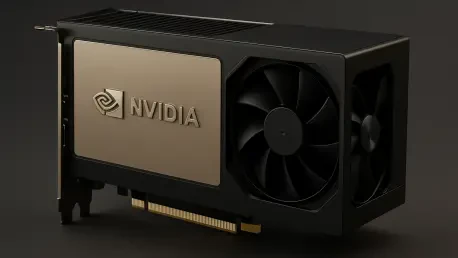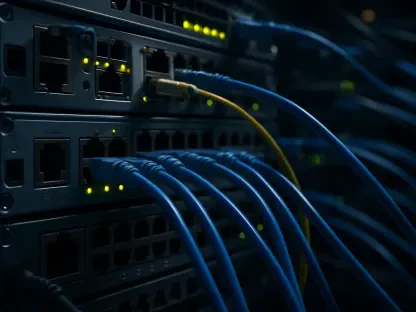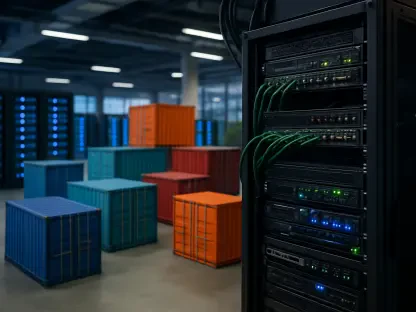What if the backbone of tomorrow’s AI breakthroughs rested on a single, game-changing partnership? Imagine massive data centers humming with unprecedented power, training AI models that redefine industries, all fueled by a strategic $900 million deal. Nvidia, a titan in AI hardware, has made a bold move by acquiring key talent and technology from Enfabrica, setting the stage for a revolution in GPU cluster performance. This isn’t just a transaction—it’s a seismic shift in how generative AI scales to meet global demands. Dive into the story of how this partnership could reshape computing as we know it today.
Why Nvidia’s Enfabrica Move Shakes Up AI Innovation
At the heart of AI’s rapid ascent lies a pressing need for raw computational power. Generative AI tools, powering everything from chatbots to creative design, demand GPU clusters capable of handling trillion-parameter models. Nvidia, already a leader in this space, recognized a critical gap in efficiency and scalability. By bringing Enfabrica’s expertise and innovations into the fold, the company aims to tackle these challenges head-on, potentially setting a new benchmark for AI infrastructure.
This deal, valued at over $900 million, isn’t merely about hardware—it’s about redefining the architecture of AI training. Enfabrica’s focus on high-performance interconnects offers a solution to bottlenecks that plague even the most advanced data centers. As major players like Microsoft, AWS, and Google push the boundaries of AI, Nvidia’s latest acquisition signals a pivotal moment, promising to unlock levels of performance previously out of reach.
Unpacking the AI Compute Challenge Nvidia Faces
The explosion of generative AI has created an unprecedented hunger for computing resources. Building GPU clusters to train models for companies like OpenAI or Anthropic isn’t just expensive—it’s a logistical nightmare. Network congestion, link failures, and memory constraints often slow down progress, costing time and billions in resources. Nvidia, despite its dominance, needed a way to push beyond these limits to stay ahead in the race.
Enfabrica emerged as the answer to this crisis with technology designed to optimize cluster efficiency. Their approach addresses core issues like data transfer delays and system resilience, which are critical for handling the workloads of modern AI. This acquisition highlights the urgency of solving infrastructure pain points, positioning Nvidia to meet the soaring demands of hyperscalers and AI developers alike.
Inside the Tech: Enfabrica’s Tools Meet Nvidia’s Power
Delving into the specifics, Enfabrica brings two standout innovations to Nvidia’s arsenal: the Accelerated Compute Fabric SuperNIC (ACF-S) and the Elastic Memory Fabric System (EMFASYS). ACF-S enhances bandwidth and cuts latency, using a multi-path design to prevent job stalls during network failures. This means AI training can continue seamlessly, even under stress, a game-changer for large-scale operations.
Meanwhile, EMFASYS introduces flexible memory access, allowing GPU clusters to maximize utilization and reduce reliance on costly high-bandwidth memory. For hyperscalers managing vast AI models, this could translate to significant cost savings—potentially slashing expenses by double-digit percentages, based on industry projections. Combined with Nvidia’s cutting-edge hardware, these tools promise to scale AI training to new heights, impacting everything from language models to autonomous systems.
The real-world implications are staggering. Training a frontier AI model, which might currently take weeks, could see dramatic reductions in time and expense. Data from recent studies suggests that optimized clusters can boost throughput by up to 40%, a leap that could accelerate innovation across sectors. This technological synergy marks a turning point for how efficiently AI can evolve.
Expert Insights on Nvidia’s Strategic Play
Industry analysts have been quick to weigh in on this high-stakes deal, with many seeing it as a masterstroke. Rachita Rao from Everest Group described it as a “brilliant sidestep of integration hurdles,” noting that acquiring Enfabrica’s talent and IP streamlines Nvidia’s path to innovation. The focus on key personnel over full company absorption reflects a growing trend of “acqui-hires” in tech, prioritizing speed and expertise.
However, not all feedback is purely optimistic. Charlie Dai from Forrester emphasized the potential for a 30% efficiency gain in Nvidia’s clusters but cautioned about regulatory oversight. The Federal Trade Commission has scrutinized similar talent-driven deals involving giants like Amazon and Microsoft, raising questions about market competition. This balance of promise and precaution underscores the complexity of navigating such acquisitions in today’s landscape.
Beyond individual opinions, the broader Silicon Valley context reveals a pattern. Deals like Meta’s $14.3 billion investment in Scale AI for talent acquisition show that tech leaders are racing to secure human capital as much as technology. This strategic focus on people and patents, while effective, keeps regulatory bodies on high alert, creating a nuanced backdrop for Nvidia’s latest move.
Charting Nvidia’s Path to AI Leadership with Enfabrica
Looking ahead, Nvidia has a clear opportunity to solidify its dominance by leveraging Enfabrica’s assets effectively. A starting point lies in integrating ACF-S and EMFASYS into existing GPU frameworks to build clusters that are not only faster but also fault-resistant. Such advancements could redefine benchmarks for training complex AI models, giving Nvidia an edge over competitors.
Beyond technology, fostering collaboration between Enfabrica’s team and Nvidia’s engineers stands as a priority. Accelerated innovation cycles depend on seamless talent synergy, ensuring that new ideas translate swiftly into market-ready solutions. Historical data from similar integrations suggests that cohesive teams can shorten development timelines by up to 25%, a critical advantage in the fast-paced AI sector.
Lastly, proactive dialogue with regulatory bodies will be essential to navigate potential scrutiny. By addressing concerns about market impact early, Nvidia can mitigate risks that have stalled other tech mergers. Tailoring these strategies to the unique demands of AI hardware ensures that the company not only maintains its lead but also sets a precedent for scalable, responsible growth in the industry.
Reflecting on a Transformative Leap
Looking back, Nvidia’s acquisition of Enfabrica’s leadership and technology marked a defining chapter in the evolution of AI computing. The fusion of advanced interconnects and memory systems with Nvidia’s robust platforms tackled critical barriers to scalability, reshaping how GPU clusters powered generative AI. This deal stood as a testament to strategic foresight, blending talent and innovation to address industry-wide challenges.
As the dust settled, the path forward became clearer for stakeholders across the AI landscape. Hyperscalers and developers were encouraged to monitor how these enhanced clusters could lower costs and boost performance in their projects. Meanwhile, industry leaders took note of the need to balance rapid advancement with regulatory compliance, ensuring sustainable progress. This pivotal moment offered a blueprint for harnessing partnerships to drive technological frontiers, paving the way for smarter, more efficient AI solutions in the years that followed.









